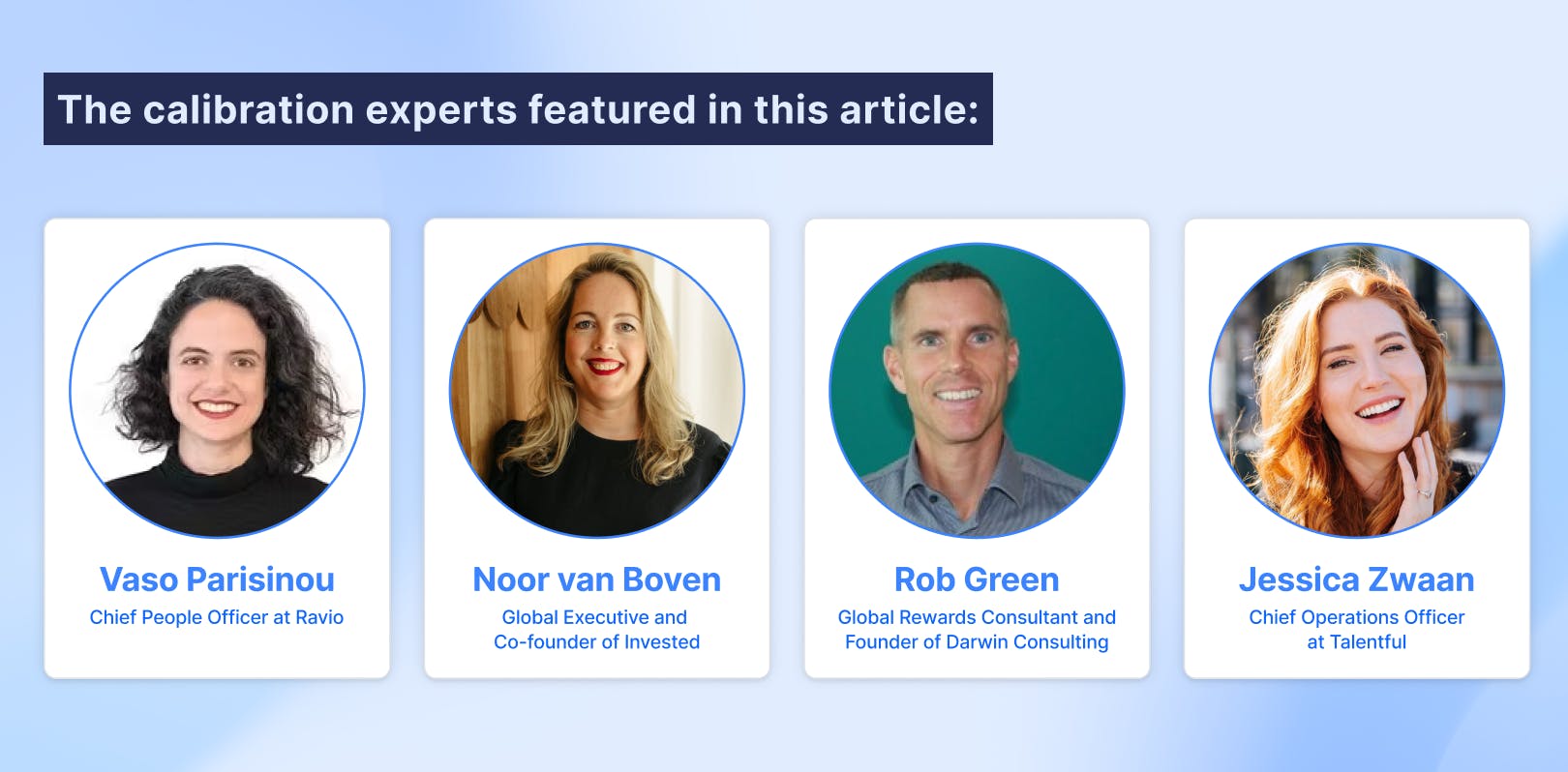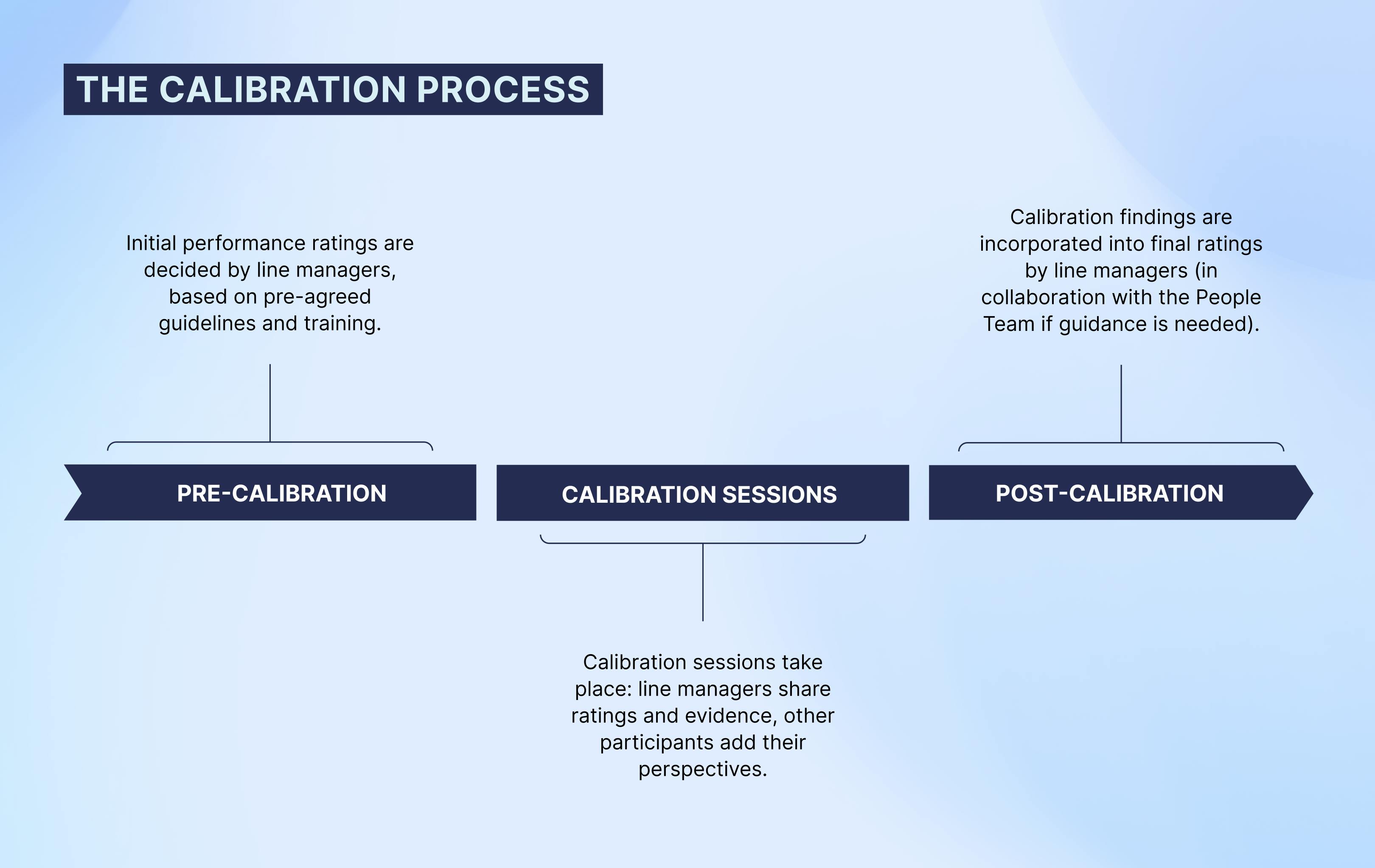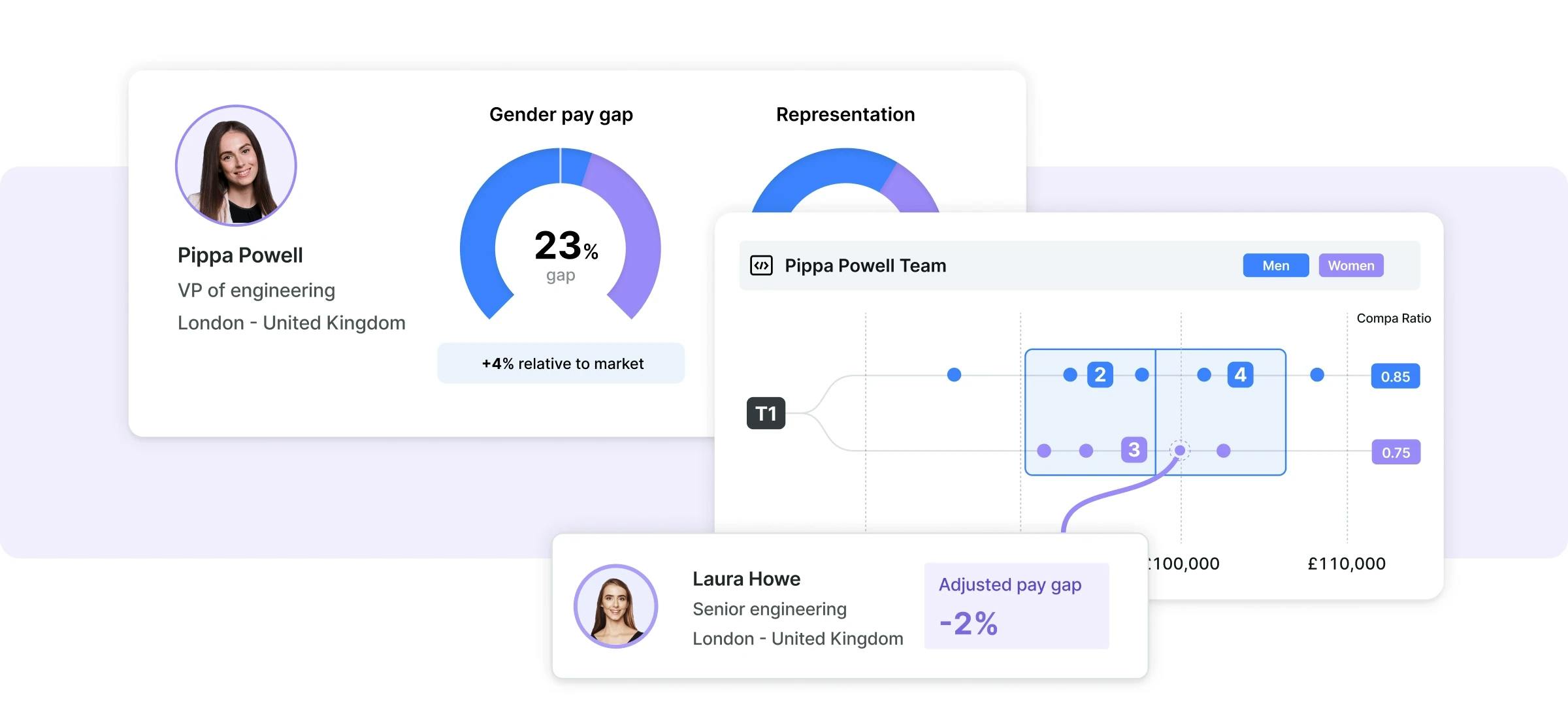How to facilitate a calibration session successfully (according to experts)

Calibration sessions are a crucial step in every compensation review.
They ensure consistent and fair decision-making, bringing performance rating and compensation decisions out into the open to ensure that every manager is interpreting performance in the same way.
They also improve manager engagement. Ensuring managers understand the approach, are involved in decisions, and have ample opportunity to share their experience with direct reports is vital for a successful compensation and performance review. Collaborating with managers can be a difficult part of the process, but calibration sessions certainly help.
However, calibration sessions can also be a bit tricky to get right. It requires careful preparation and facilitation by People Teams to be effective.
In this article, we’re sharing advice from seasoned People and Reward Leaders to help you run your most effective calibration session yet.

Subscribe to our newsletter for a monthly treasure trove of insights from Ravio's compensation dataset and network of Rewards experts, to help you navigate a career in compensation 📩
How are calibration sessions used within a compensation review?
Calibration sessions are usually used to agree on performance ratings, and so are most likely to be used during compensation reviews at companies that use a pay for performance model for compensation adjustments.
In this scenario the typical process goes like this:
- Line managers decide on a performance rating for each of their direct reports, based on pre-agreed guidelines and indicators.
- During the calibration session line managers share the performance rating for each employee as well as evidence to justify the rating based on the guidelines.
- All calibration session participants (other line managers plus People Team) discuss and challenge the rating given, until consensus is reached.
- After the calibration session, the agreed performance ratings are approved by the executive team and finalised – and this then informs the compensation adjustment each employee will receive during the compensation review.
At small organisations there may be a single calibration session with all line managers. At larger organisations there will be many calibration sessions, usually split by job function and job level. In this scenario, it’s important to group together teams who perform similar work or work of similar value, because it’s vital for pay equity that consistent decisions are made for those teams. It’s common in tech startups, for instance, to split calibration sessions into tech and commercial teams, because there are often different approaches across tech and non-tech roles in terms of job architecture, levelling, and salary bands.

What are the benefits of calibration sessions?
There are three major benefits to incorporating calibration sessions into a performance or compensation review:
- Increased objectivity. There’s always some level of subjectivity and bias involved in performance ratings, which is why some companies (like Pipedrive) opt not to include performance ratings in salary adjustment decisions. Calibration sessions reduce that subjectivity by making sure that all line managers are interpreting guidelines and performance indicators in the same way, bringing increased consistency and objectivity to the decisions made – which is vital for maintaining internal pay equity.
- Happy managers. Calibration sessions ensure a clear and consistent approach to performance and compensation decisions, and they ensure that managers are fully involved in the process and decision-making alongside their fellow managers. Both of these factors make it easier for line managers to understand the rationale behind decisions which, in turn, makes communicating those decisions to direct reports feel less nerve-wracking.
- Happy employees. Employees can feel confused, disappointed, or frustrated if the outcome of a performance or compensation review is not what they expected. If managers are able to clearly explain the rationale behind a performance rating and compensation adjustment, then it’s much easier for employees to understand how that decision has been made, feel reassured that a fair process has taken place, and take any feedback on board.
“The purpose of a calibration session is to bring all parties together for a birds eye view on performance. It gives room for everyone to challenge each other's perceptions and ultimately to ensure that performance is being evaluated fairly, in the same way for every employee."

Chief People Officer at Ravio
How to facilitate calibration sessions effectively: expert advice on 11 common challenges
Facilitating calibration sessions is never an easy task for People Teams.
They involve a lot of planning and preparation before the sessions even begin. The meetings themselves can be taxing to facilitate with lots of discussion points and stakeholders to wrangle. They can also be highly emotional meetings, because managers typically care deeply about their direct reports and want to advocate for them. Plus, there’s the anxiety-inducing threat of making a data privacy mistake, such as someone accidentally sharing the performance rating of someone in the room.
And with all that complexity, even when you think you’ve achieved the perfect calibration process, it might not work as well for a different team with a different culture.
“My best advice is to think of it as an iterative process that can always be improved,” says Vaso Parisinou, Chief People Officer at Ravio. “Ask each calibration group for feedback immediately after the meeting whilst it’s top of mind, and use that feedback to make changes for the next calibration session to take place.”
Whilst every team is different, there are a few challenging scenarios which seem to arise most commonly for when it comes to calibration sessions – let’s take a look.
Scenario 1: Calibration sessions become an exhausting, never-ending process
Even just one or two calibration sessions can take a lot of time and effort to get right with everything involved – from preparing guidelines, to briefing managers, to facilitating the sessions, to consolidating the results, to getting final alignment from executives, to finalising performance ratings and compensation adjustments.
In bigger organisations, this is exacerbated, and the calibration process can feel never-ending. Vaso recalls her time at Deliveroo when it was a company of around 3,000 employees. “For a full month I did nothing but work on calibration sessions.”
Not only is this exhausting for those involved, but it can also damage the process. “If you do several calibration sessions back to back, discussions about employees all start merging into one,” Vaso says. “It isn’t fair on employees because they aren’t getting the best version of you or of the process, which is supposed to ensure a fair result for them.”
The solution? For Vaso this can be a sign that there’s a need for “more People people to run the calibration sessions, or more time to spread them out over.” She also suggests inviting an additional team member to transcribe or test out AI meeting assistants, as trying to take detailed notes whilst facilitating the session is often the problem.
In her calibration sessions guide, Jessica Zwaan, Chief Operating Officer at Talentful suggests that larger organisations implement a clear structure for running calibrations sessions with each level of management: “Each level should calibrate their own direct reports, and the level above should calibrate their direct reports and ‘spot check’ the evidence of a random selection of individuals within their sub-team, as well as looking at the overall results and trends of their functions”.
In practice, this means that there are three batches of calibrations sessions to run, which can help to break up the process into more manageable chunks:
- Direct managers meet first to calibrate ratings for the individual contributors in their respective teams – with one calibration session per team e.g. product and design, engineering, marketing, sales and customer success, operations.
- Managers of managers then meet to calibrate ratings for their direct reports (i.e. the direct managers) and to spot check the ratings agreed on in the direct manager calibration sessions – this will likely be two sessions, one for product teams and one for commercial.
- Executives meet finally to calibrate ratings for their direct reports (i.e. the managers of managers), but mostly to look at overall trends and ratings to ensure there is overall alignment and leadership sign off on the final decisions.
Scenario 2: Discussions keep veering into the territory of subjectivity and unconscious bias
Calibration sessions are designed to make the performance and compensation review process less subjective, but that doesn’t mean that they aren’t prone to bias themselves. It’s common, for instance, to see affinity bias as managers tend to favour their own direct reports over other employees. Of course, gender and ethnicity bias are always a risk (which we’ll discuss separately in scenario 3).
These factors can seriously damage the objectivity of the calibration session and, therefore, its effectiveness in ensuring fair and consistent decisions.
For Noor van Boven, Global Executive and Co-founder of Invested, it’s crucial to invest time beforehand on calibration training for managers, including unconscious bias.
💡 What should calibration training for managers include?
As Noor has pointed out here (and as our other experts will continue to reiterate throughout this article), providing training and guidelines for managers on how to prepare for and participate is crucial for effective calibration sessions.
Noor’s calibration training always includes:
- Explain the purpose of calibration sessions – the importance of gathering all perspectives and coming to a shared decision
- Explain the structure of the meeting and what to expect
- Educate on the main types of unconscious bias and how to avoid them – including real-world examples
- Explain what managers should prepare in advance – typically managers will submit initial ratings for all direct reports, and this will be circulated so that all other managers can consider discussion points beforehand
- Share ‘do and don’t’ guidelines on how to talk about employee performance during the calibration session e.g. do share examples, don’t use vague language, etc.
- Explain what the facilitating People Leader will prepare in advance – Noor will always analyse the pre-calibration sheets to find initial trends to focus discussion on e.g. this team is entirely in the upper quartile, do we agree that they are the highest performing team in the business?
“Provide educational material for managers on the main types of unconscious bias that can arise during the meeting,” Noor says, “and always include examples.” That’s examples of biased comments, as well as examples of how to raise a concern about those comments constructively. “Using the right language is really important to avoid managers becoming defensive when bias is brought up.”
This aligns with one of Jessica Zwaan’s ‘golden rules’ for calibration sessions too: “during discussions ‘show, don’t tell’”. Bias is often introduced when managers have a firm belief that their direct report is high-performing, but don’t have clear evidence or examples to back this up. Making this a requirement in the guidelines or manager briefing before the session means that they will come prepared.
Noor will then open each calibration session with a reminder of those types of unconscious bias so that it remains top of mind and can be called back to throughout. She suggests “trying to keep it lighthearted where possible” because “bias is a serious topic and it can feel uncomfortable to be called out on it.”
This is something that resonates with Vaso too. “It’s important to create a comfortable space where challenging bias is welcomed.” Her advice is to reference a real-world example. “When I worked in recruiting, one of my peers pointed out that I often seemed to rate candidates that looked similar to me – dark hair, dark features – higher than others; I was absolutely mortified!” As the facilitator of the meeting “being vulnerable yourself helps to create that comfortable space”.
The facilitator also must always be on the lookout for signs of bias or subjectivity creeping into the conversation. “As well as running the session, it’s important to remember that the People Leader in the room is the neutral body and there to prevent bias” Vaso says.
In previous roles, Vaso has also found it highly effective to bring other neutral parties into the room. “A small committee of neutral team members who are widely trusted across the organisation and who are there specifically to listen for bias can be hugely beneficial to bring fresh eyes to the process.” Of course, if you implement this it’s vital to brief those neutral parties to ensure they understand the calibration guidelines and the discretion required.
Scenario 3: It’s difficult to tell if gender or ethnicity bias is informing the performance discussions
Unconscious bias also extends to (even) more harmful forms than those highlighted in the previous scenario, including gender bias and ethnicity bias.
It’s worth separating this out into a separate scenario because of the importance and growing emphasis on pay equity, especially with new laws like EU Pay Transparency Directive soon to be implemented.
Making decisions ‘by committee’ in a calibration session setting can lead to widening pay inequities. For instance, if that committee unconsciously favours men then male employees will be systematically awarded higher performance ratings and, therefore, higher salary increases and a greater likelihood of promotion – resulting in an increased gender pay gap.
It’s, therefore, critical as a People Leader to ensure this doesn’t happen. The best way to do this is to “bring pay equity data into the room”, says Vaso Parisinou, CPO at Ravio.
There are a couple of different approaches that Vaso favours.
Firstly, she suggests opening each calibration session by sharing the company’s current pay equity metrics to ensure this information is top of mind throughout the meeting.
For gender bias, that would include the gender pay gap (adjusted and unadjusted overall, as well as broken down into different job functions and job levels), as well as the representation of women in the company – especially in leadership roles.
It can also be helpful to show the salary band position for the group of employees being calibrated and highlight any trends e.g. women are more often at the lower end of their band.
A tool like Ravio can help with this analysis of the current situation, doing the calculations for you and giving a visual depiction of pay equity metrics and salary band positions to share on-screen or circulate pre-meeting.

Vaso highlights that it’s then also important to look at what the ‘after’ will look like too. “You need to understand how the performance ratings agreed upon during the calibration session will impact pay equity – if we made compensation adjustments based on those ratings, would our gender pay gap worsen?” If so, then this needs to be looked at critically.
Another approach that Vaso uses is to include a final discussion stage in the calibration session which anonymises the employees. “Take the performance ratings that have been agreed on and anonymise everything apart from the biases that you want to check for,” Vaso says, such as showing only the gender of employees against the agreed ratings. “This makes bias clear, because suddenly everyone in the room can see if we’ve been more likely to give male employees a top performance rating.”
Scenario 4: Discussions become unfocused and there’s a lack of time to cover every employee
During calibration sessions there’s normally a relatively short amount of time to cover a lot of employees, and it can be tricky to maintain focus.
The traditional advice is that every employee deserves an equal amount of discussion during calibration. Noor van Boven, Co-founder of Invested, disagrees. “There’s usually immediate consensus on top performers and each person’s input only echoes the previous point – you could easily waste half of the meeting celebrating champion employees.”
Her advice is to skip that with a two-part meeting:
- Part 1: Key trends. The People Leader raises insights from the pre-calibration ratings that warrant particular discussion, such as a particularly low or high-performing team.
- Part 2: Controversial employees. ‘Controversial’ employees where managers have differing perspectives or additional insights to share require more time. Noor suggests prioritising this second part of the meeting from most to least controversial. Circulating initial ratings pre-meeting and asking managers to highlight employees that they disagree with or would like to discuss helps to save time and get to those controversial employees quickly.
It’s worth noting that, whilst focus is important, it can sometimes be beneficial to let the conversation wander.
Vaso highlights that “it can be where the most vital discussion and challenges arise.” Her experience is that you typically get a feel of when the conversation is valuable and should be kept going, and when to refocus.
Scenario 5: Managers struggle with what information to share when talking about their direct reports
The strength of the insights and evidence that managers bring to the calibration session for each of their direct reports is make or break for an effective calibration session – but managers are sometimes unsure about this.
Noor highlights that this is especially true for newer managers who haven’t been involved in many calibration meetings before.
“Calibration is a muscle that needs training. Going to the gym once doesn't make you an olympic athlete, and the same is true for calibration sessions: the more review cycles you experience, the easier it becomes.” If possible, she suggests ensuring a mix of experienced and new managers in each calibration session so that those new to calibration can observe and learn from their peers.
For Vaso Parisinou it’s key to “give lots of direction and guidance to managers in advance on how to give feedback in a productive way” – and we saw this earlier in Noor’s calibration training guidance too.
Vaso recently ran calibration sessions for Ravio’s compensation review, first one for the tech side of the business and then for the commercial side. “One of the key pieces of feedback from the tech calibration session was that participants didn’t feel confident on exactly what they should talk about for each employee.” This feedback was immediately put into action for the commercial calibration session, ensuring managers had a clear structure to follow for their preparation, with evidence for each key performance indicator used in Ravio’s level and career frameworks.
This also serves as a great reminder of why “it’s so important to ask for feedback immediately following every calibration session, and use that feedback to keep iterating on and improving the process.”
Jessica Zwaan advises that it’s also important to give managers examples of what not to say, with another of her ‘golden rules’ being that managers should “avoid common generalities when discussing performance, and instead provide specific examples of actions or behaviours and their impact” – with particularly common language including “shortcuts like ‘good/bad communication’, ‘presence’, ‘visibility’, and ‘confidence’.”
“For your managers, calibration is a muscle that needs training. Going to the gym once doesn't make you an olympic athlete, and the same is true for calibration sessions: the more review cycles you experience, the easier it becomes.”

Co-founder of Invested
Scenario 6: The meeting becomes less of a group discussion, and more of a one-by-one presentation
The whole point of a calibration session is to raise all perspectives and find group consensus to ensure consistent and fair decisions on employee performance and pay adjustments. So when the meeting stops feeling like a group discussion, it’s a problem.
Noor van Boven has experienced this many times. “Sometimes it will stop being a conversation, and instead feel like each manager is presenting to you as the People Leader,” she says, “when really my opinion is irrelevant, they need to be presenting to and discussing with each other.”
Like with unconscious bias, addressing this challenge comes down to two things:
- Clear guidelines and training before the calibration session to ensure every manager understands the purpose and format of the meeting.
- The vital role of the People Leader as facilitator to point out when this is happening and bring it back to a conversation, inviting others to input on the employee at hand.
Scenario 7: There’s difficulty reaching consensus on an employee’s rating
If participants strongly disagree about the performance rating of an employee, it can be difficult to reach consensus.
When it’s a struggle to reach consensus, it’s usually because there’s a lack of clarity of nuance in the definition for each performance rating. So, for Global Rewards Consultant Rob Green, the key is to “capture the outcomes in a targeted way through clear ratings.”
There should be a clear set of performance factors which defines whether employees are meeting (or exceeding) expectations for each role in the team. “This will improve the objectivity of the assessment by giving an anchor example for managers to make a fair comparison to,” Rob says. Those factors will typically be the same factors as are used in the company’s level framework – Ravio’s, for instance, are: leadership, impact, scope, autonomy, expertise, and complexity.
Alongside this structure, though, Noor van Boven advises to “keep in mind that there is no ‘correct’ answer, because employee performance and potential isn’t an exact science.”
If discussion becomes heated or a manager doesn’t seem open to a differing viewpoint, it’s the role of the People Leader to bring the conversation back to a “constructive middle”, as Noor puts it. “Break into the conversation, give a summary of the points raised so far, acknowledge the difference in opinion, and ask the manager if they’ve received enough information and evidence to incorporate this into their rating.”
Typically line managers do have ownership over the final performance rating for their direct reports. Noor advises to “make it absolutely clear that managers cannot ignore the input from their peers, and must take it seriously.”
Clear calibration guidelines and training are again crucial here. “Give key principles in terms of how managers should use the information gathered during the calibration session towards the final rating,” she says, with one example being that “it should be impossible for an employee to receive the highest performance rating if even one person in the room disagrees with that rating – because high performance is always clear across the board.”
If it’s a case where consensus clearly hasn’t been reached, then Noor suggests following up with the manager outside of the calibration session to support them in deciding the final performance rating and, most importantly, to provide guidance on how to communicate the differing perspectives raised to the employee (see scenario 9).
Scenario 8: The senior leadership team wants the final say on employee ratings
The point of calibration sessions is to surface all perspectives and reach group consensus on a fair outcome for all employees. So when senior leaders want to hold the final decision to be able to ‘correct’ ratings, it’s a major concern. As Noor van Boven puts it: “That’s the end of effective calibrations – it’s a group conversation, not one person dictating the answer.”
Her advice is to always include senior leadership in calibration training before the meetings take place to ensure that they understand the purpose of calibration, and emphasise the importance of everyone respecting the outcome of the sessions.
In Noor’s experience, when senior leaders want to take over the decision in this manner it’s often because they are concerned about performance overall, and want to see improvements across the board. In this scenario it can help to “invite senior leaders to join the calibration sessions as an opportunity to discuss expectation setting for the following year.”
Scenario 9: Managers use the calibration session as a scapegoat in difficult conversations with employees
One of the trickiest parts of running a calibration session is the moment when the People Team hand over the reins to line managers. From there on, it's up to managers to inform their employees about their performance rating and compensation adjustment. The conversations that happen between manager and employee are absolutely critical to the success of the review, but it’s now out of our control and many managers struggle with it.
It’s common for managers to ease the burden by using the calibration session as a scapegoat – ‘I advocated for you, but the decision was made by committee and it was out of my hands’. If this is taken as fact, it can reflect poorly on the People Team who are running the process.
Vaso feels strongly that this should actually reflect poorly on the manager themselves. “To me, this is an indication that a manager is not performing their role effectively,” she says, “it is the responsibility of a manager to communicate the information to their direct report in a clear and constructive way, even if they don’t personally agree with the final decision”.
Jessica Zwaan agrees. Another of her ‘golden rules’ for calibration sessions is to make it clear before and during the meeting that: “As a leader, you are responsible for owning and delivering any employee-facing messaging resulting from these discussions. Never ‘pass the buck by saying, ‘the calibration room said this’ or ‘here is what the other leader(s) thought.’” Like Vaso, she suggests strong action if this issue does arise: “this kind of behaviour is disciplinary and should not be tolerated.”
It’s important that managers are given the tools and training to ensure that they feel confident to properly explain the decisions made – Vaso suggests offering practice sessions to help managers who are feeling nervous about it. But, if the process is clearly documented and guidance has been given, and managers are still found to be communicating in this way, then the next step is to go to the manager’s manager and explain clearly why this is unacceptable, and be firm and clear that it will reflect on their rating as a managerial role.
Noor also suggests giving managers examples of the kind of language to use. “People teams will often underestimate how anxious managers are about communicating performance outcomes to employees. We need to give them actual sentences and examples on how to verbalise to help.” This is especially true when differing perspectives have been raised on an employee during calibration. “It’s important to share this information with employees, because the all-round feedback is often more valuable than the final performance rating for them.”
💡 How to tell employees about viewpoints raised during calibration sessions
As Noor highlights here, it’s important to share the discussion that happens during calibration with the employee in question.
So what’s the right way to do this?
Here’s one example from our conversation with Noor.
The wrong language: “I think you are a great communicator, but team X does not agree.”
The right language: “I have seen you communicate effectively in our team, but the feedback in the calibration session raised that this effectiveness is not consistent across all other teams. Let's discuss how we can take something you do comfortably and with positive impact within our team, and raise the effectiveness with other teams in future.”
Scenario 10: Calibration sessions are a black box process for employees
Managers meeting to discuss employee performance behind closed doors can feel like a negative thing for employees that aren’t involved in the calibration sessions. They probably don’t even know what ‘calibration’ is in this context.
This can leave employees feeling that the review process hasn’t been a fair one – and it also makes it easier for managers to use the calibration session as a crutch in difficult conversations (see scenario 9).
For Noor, employees should have the same level of understanding on calibration sessions as the managers participating in them. They should know what calibration is, why it’s important, and be clear that managers are expected to take the perspectives of their peers seriously but that they hold ownership over the final performance rating.
Vaso agrees, and adds that it’s important to give employees as much detail as possible about the discussion that took place: “there’s a massive difference for the employee between only just scraping a ‘meets expectations’ and being on the cusp of ‘exceeds expectations’, and that’s detail that the employee deserves to know.”
Plus, when employees understand how the calibration process works, they are in a better position to challenge it and suggest improvements for the next time round. “Some of the best feedback I’ve received has come from employees with fresh minds and fresh perspectives who are able to point out issues with compensation review processes that I’ve taken for granted for years”, Vaso says.
“Some of the best feedback I’ve received has come from employees with fresh minds and fresh perspectives who are able to point out issues with compensation review processes that I’ve taken for granted for years.”

Chief People Officer at Ravio
Streamline your compensation reviews with Ravio
Calibration sessions are one element of a successful compensation review – but there’s a lot more that goes into the process too. While we can't eliminate all the challenges faced by compensation leaders, we are here to share the load.
From total novices to seasoned reward experts, Ravio is designed to help comp teams feel confident navigating both the art and science of compensation review planning:
- Scenario model compensation adjustments and budgets
- Design a merit matrix
- Build and refresh salary bands using real-time market data
- Instantly see the role of bias through pay equity analysis and salary band positions broke down by gender
- Share plans and getting buy-in across the board
- Communicate the ‘why’ behind compensation decision.
With Ravio, it’s easy to navigate the complexities of compensation and turn a once-fraught process into a seamless experience.
To learn more, book a demo with one of our compensation experts, or try the Ravio platform out with three free benchmarks.